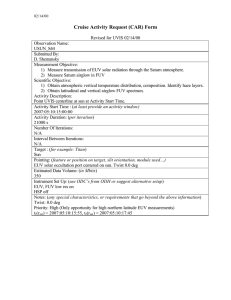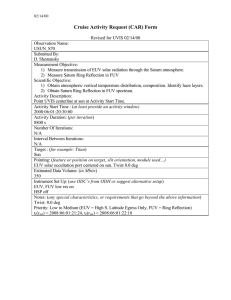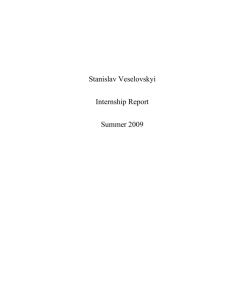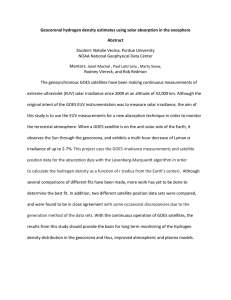Simultaneous Reflection and Transmission Measurements
advertisement
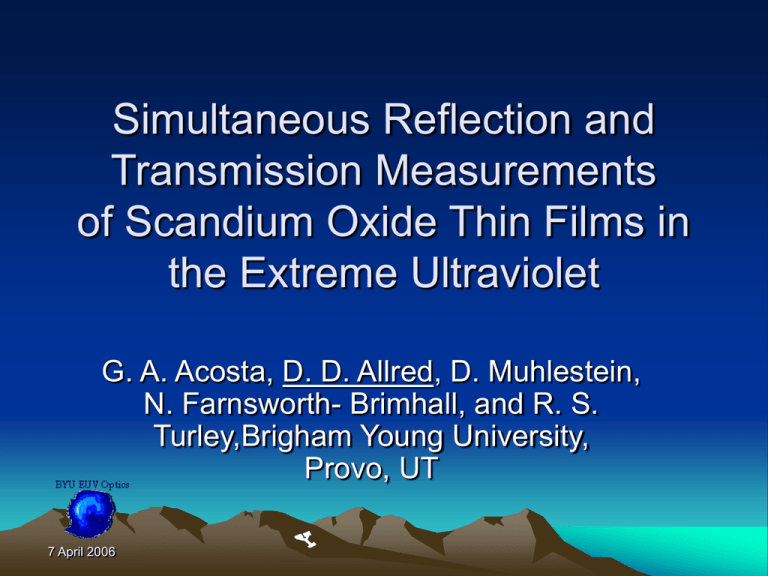
Simultaneous Reflection and Transmission Measurements of Scandium Oxide Thin Films in the Extreme Ultraviolet G. A. Acosta, D. D. Allred, D. Muhlestein, N. Farnsworth- Brimhall, and R. S. Turley,Brigham Young University, Provo, UT 7 April 2006 Overview • Our goal is a better understanding of the optical properties of materials in the EUV. EUV Astronomy • The materials we have been studying most recently are ThO2 & Sc2O3 (scandia) The Earth’s magnetosphere in the EUV • GAA’s project was to see if we could get n as well as k from samples set up to measure transmission in the EUV. • The films were deposited DIRECTLY on Absolute EUV silicon photodiodes. $$ 7 April 2006 2 Important info • The EUV offers special challenges – Where in the EM spectrum is EUV? • 1895 Roentgen discovers ~10 keV • 20 years later understood ~ – What is between UV (3-7 eV) & x-rays? • VUV, • EUV & soft x-rays about 10 to 100 energy of UV – High absorption k = β = αλ/(4π) – Refractive index ~ <1; n = 1- 7 April 2006 EUV Astronomy The Earth’s magnetosphere in the EUV 3 EUV Applications • Extreme Ultraviolet Optics has many applications. • These Include: – EUV Lithography- α & β- 2008 – EUV Astronomy – Soft X-ray Microscopes • A Better Understanding of materials for EUV applications is needed. 7 April 2006 EUV Lithography EUV Astronomy The Earth’s magnetosphere in the EUV Soft X-ray Microscopes 4 Optics like n-IR, visible, & nUV? First you need a light. 7 April 2006 5 Optics like n-IR, visible, & n-UV? • How to manipulate light? • Lens? Prisms? Mirrors? Diff Gratings? ML interference coatings? • We need to have optical constants; • How to get in EUV? – Kramers-Kronig equations n () k () – Variable angle of reflection measurements, – Real samples aren’t good enough. Roughness 7 April 2006 6 Transmissionk? • • • • T = (Corrections) exp (-αd); Corrections are due to R and can be small At normal incidence R goes as [2 + β2]/4 If film is close to detector scattering due to roughness etc. is less important. • But how to get an even, thin film? – A very thin membrane? 7 April 2006 7 Transmission thru a film on PI 7 April 2006 8 But reflectance is a problem 7 April 2006 9 The problem is waviness of substrate. Sample on Si does fine. 7 April 2006 10 The Solution: Deposit the film on the detector • Uspenskii, Sealy and Korde showed that you could deposit a film sample directly onto an AXUV100 silicon photodiode. (IRD) and determine the films transmission ( by ) from the ratio of the signal of the coated diode to an uncoated diode. • SPIE proc. (2002) 7 April 2006 11 Our group’s improvements 1. Measure the reflectance of the coated diode at the same time I am measuring the transmission. And 2. Measure both as a function of angle. And 3. Get the film thickness from the (R) interference fringes (@ high angles). 7 April 2006 12 Comments 1. Either T or R have n and k data, but 2. Transmission has very little n data when d is small (the EUV). 3. Reflection n, k and when interference fringes are seen, and 4. It has thickness (z) data. What follows shows how we confirmed thickness for air-oxidized Sc sputtercoated AXUV diodes. 7 April 2006 13 Fitting T() to get dead layer thickness (6nm) on bare AXUV diode @=13.5nm 7 April 2006 14 0 Interference in R (50<φ<70 ) zfit=19.8 nm @ =4.7 nm 7 April 2006 15 The complete set of R data (6<θ<200) zfit =28.1 nm @ =4.7 nm 7 April 2006 16 We might gone with z= 24 nm, but 7 April 2006 17 We looked at another = 7.7nm; needs z=29 nm 7 April 2006 18 And the =4.7nm data is OK 7 April 2006 19 Reflectance and transmittance of a ThO2-coated diode at 15 nm fitted simultaneously to obtain n&k • Green (blue) shows reflectance (transmission) as a function of grazing angle ()* • Noted the interference fringes at higher angles in R. * is always from grazing incidence 7 April 2006 20 R &T of a ThO2-coated diode at 12.6 nm fitted simultaneously to obtain optical constants. • The fits were not very good at wavelengths where the transmission was lower than 4%. • All of these fits were trying to make the fit of transmission narrower than the data was. 7 April 2006 21 “Conclusions” • Thin films of scandium oxide, 15-30 nm thick, were deposited on silicon • photodiodes by – Sputtering Sc from a target & letting it air oxidize OR – reactively sputtering scandium in an oxygen environment. • R and T Measured using synchrotron radiation at the als (Beamline 6.3.2), at LBNL – over wavelengths from 2.5-40 nm at variable – angles, were taken simultaneously. 7 April 2006 22 Acknowledgements • The BYU EUV Thin Film Optics Group, past and present. • ALS for beam time under funded proposals. • BYU Department of Physics and Astronomy, including support staff: Wes Lifferth, W. Scott Daniel and John E. Ellsworth. • BYU Office of Research and Creative Activities, and Rocky Mountain NASA Space Grant Consortium for support and funding. • SVC for scholarship support for Guillermo Acosta when this work was begun. • Alice & V. Dean Allred (with matching contributions from Marathan Oil Company), • ALS for beam time under funded proposals 7 April 2006 23 Not shown in talk • Data collected revealed the positions of electron transitions, which are displaced from the positions predicted by standard methods of calculation. • Analysis of the data has provided optical constants for scandium oxide thin films, which have potential for use as a barrier or capping layer to prevent oxidation of sensitive optical coatings. 7 April 2006 24
